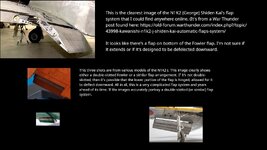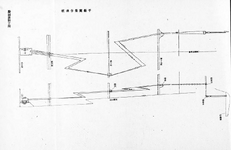AerialTorpedoDude69
Airman 1st Class
- 130
- Mar 1, 2022
EDIT: The George did not have double-slotted Fowler flaps. It had a unique flap system which combined single-slotted Fowler flaps with split flaps on the aft flap. The flaps were substantially different from other Fowler flaps in that it was designed for fighters rather than for bombers. The George's flap system would have made it one of the best dogfighters for its weight class. Thanks to
 MiTasol
for answering this question!
MiTasol
for answering this question!
Hi everyone, I found something interesting while looking over the George's unique flap system and hoped to get your help.
Does the N1K2-J George's combat flaps look like they're double-slotted Fowler flaps? Or am I seeing things? For more information on the George's flap system, check out this amazing post at the old War Thunder forum.
This is highly significant because it could mean that the George was the first aircraft to use double-slotted Fowlers. Regular Fowler flaps go back to the 1920s. They increase wing area which decreases stall speed, while limiting drag. The first aircraft to have electrically activated Fowler flaps is the Lockheed Model 10 Electra, which is what Amelia Earhart and Ted Noonan flew on their ill-fated flight in 1937. But I can't find what the very first aircraft was to use double-slotted.
Unfortunately, I can't verify that the George's flaps are double-slotted. There's a single image I think taken during a restoration which could suggest a double-slotted design. There are several N1K2-J models that clearly sport double-slots, but those could have been made in error.
The reason double-slotted flaps are so interesting is because of their complexity and effectiveness. The reason they are still used today is because they allow for large-bodied aircraft to substantially increase lift, with the only tradeoff being an increase in complexity and a slight increase in weight. For aviation buffs, it's fascinating to know where this design originated from. If it does originate with the N1K2-J, then the designer deserves recognition for this achievement.
Hi everyone, I found something interesting while looking over the George's unique flap system and hoped to get your help.
Does the N1K2-J George's combat flaps look like they're double-slotted Fowler flaps? Or am I seeing things? For more information on the George's flap system, check out this amazing post at the old War Thunder forum.
This is highly significant because it could mean that the George was the first aircraft to use double-slotted Fowlers. Regular Fowler flaps go back to the 1920s. They increase wing area which decreases stall speed, while limiting drag. The first aircraft to have electrically activated Fowler flaps is the Lockheed Model 10 Electra, which is what Amelia Earhart and Ted Noonan flew on their ill-fated flight in 1937. But I can't find what the very first aircraft was to use double-slotted.
Unfortunately, I can't verify that the George's flaps are double-slotted. There's a single image I think taken during a restoration which could suggest a double-slotted design. There are several N1K2-J models that clearly sport double-slots, but those could have been made in error.
The reason double-slotted flaps are so interesting is because of their complexity and effectiveness. The reason they are still used today is because they allow for large-bodied aircraft to substantially increase lift, with the only tradeoff being an increase in complexity and a slight increase in weight. For aviation buffs, it's fascinating to know where this design originated from. If it does originate with the N1K2-J, then the designer deserves recognition for this achievement.
Attachments
Last edited:




